More about the series NexImage...
Large, highly sensitive CMOS sensor - ideal for imaging the Sun and Moon. Plus 'crop mode' for a higher frame rate with planets!
The NexImage Burst camera lets you take high resolution images of the Sun, Moon and planets. This innovative camera is user-friendly - making it particularly suitable for beginners - and has one of the best CMOS sensors around for planetary imaging. You can use it with any telescope that has automatic tracking.
- ultra-sensitive Aptina AR0132 CMOS Sensor - CMOS sensors are beginning to supersede CCD sensors in planetary imaging, and this Aptina sensor shows just where things are heading. This enhanced version of the popular MT9M034 sensor offers the perfect combination of speed, sensitivity and quality.
- an excellent way to get started in planetary photography - to use the NexImage Burst camera, you simply need to point your telescope at the Moon, Sun (with appropriate filter!) or Planet and take a video. 'Subframing' allows the NexImage Burst to limit the image actually videos to section of the image, thus allowing a frame rate of more than 120 images per second.
- the included software (Windows only) then analyses each frame, rejects the blurred ones and 'stacks' the good ones together. The result is a bright, clear image with the best possible colour and detail.
The NexImage Burst Monochrome is a black and white camera, where the entire chip is used for each colour, making it much more sensitive than a colour camera. In addition, you will need the Skyris filter wheel and colour filters for creating colour photos.
Intended use of the camera
- Mercury, Venus, Uranus and Neptune - very good
- Mars, Jupiter and Saturn - very good
- entire lunar disk - good
- detail of lunar disk - very good
- entire solar disk - good
- detail of solar disk - very good
Note: Only photograph the Sun using a special solar filter.
Our expert comment:
We recommend that you always install the latest camera driver.
You can find the driver below the word Support at the bottom of the product page for each camera:
http://www.celestron.com/browse-shop/astronomy/astroimaging-cameras
We recommend the Sharpcap freeware as image acquisition software:
http://www.sharpcap.co.uk/sharpcap/downloads
There is a good video tutorial for this software on Youtube:
https://www.youtube.com/watch?v=4UC0KmPkuy4
(Bernd Gährken)






